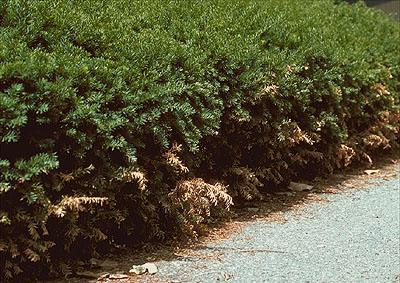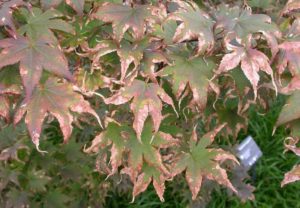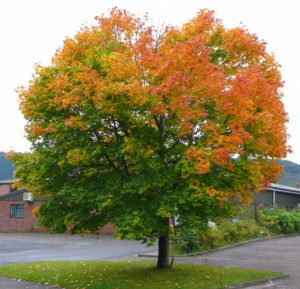How to minimize salt injury to trees and shrubs

Browning on junipers from salt damage. Photo: U. of Maryland Extension
Every winter brings its annual a-salt on roads and walkways. In icy conditions, salt may be necessary for safety, but too much of it is worse than a bad pun. Cars, equipment, and concrete suffer in obvious ways, but damage to trees and other woody plants is less visible. Salt injures trees and shrubs by several means.
When road-salt spray hits twigs, buds and, in the case of evergreens, foliage, such direct contact causes yellowing of needles, and subsequent death of evergreen twigs and limbs. It also leads to stunted or deformed growth, such as witches’ brooms, on hardwoods. Severe or repeated direct exposure, especially for sensitive species like white pine or cedar, can kill the whole tree.
Less noticeable is the effect salt has on roots when it is directly deposited onto a tree’s root zone by plowing or through runoff. For an established tree, its root zone is two to three times its branch length or drip line. High concentrations of salt in the soil may kill a tree over the course of just a few years. But even at lower concentrations it makes water less available to tree roots, producing drought stress even in the presence of moisture.

Marginal leaf scorch on a Japanese maple. Though usually the result of drought, salt damage to roots can cause scorch during seasons with normal rainfall. Photo: UC Master Gardener Program of Contra Costa County
This latter injury is chronic, and can show up as browned leaf edges, a condition known as marginal leaf scorch, in the hottest part of the summer. In July and August, deicing salt is the last thing on people’s minds in terms of a diagnosis. It can also manifest as subtle, cumulative damage that weakens a tree year after year until eventually it succumbs to opportunistic agents such as insects or diseases. Many large old sugar maples planted on roadsides have fallen victim to cumulative stress, with salt at or near the top of the list of factors.
Salt actually damages soil structure, causing what is known as sodium compaction. Roots need to get oxygen through soil pores, and healthy soil forms tiny clumps which form natural channels for air to pass. The chemical bonds holding the clumps together are broken by salt, and as a result the pore spaces collapse, restricting roots’ access to air and further stressing trees.
While it was formerly assumed that rain or heavy irrigation could wash road salt from the soil each summer, it now appears this is rarely the case, and that salt levels often slowly build over time. An approximation of soil-salt levels can be made using a conductivity meter to check the electrical conduction in a soil slurry. Readings over about 3,000 micro-mhos per square centimetre may indicate a problem.

A Norway maple with falliage. This species is more salt-tolerant than native maples and can be planted close to areas where road salt may be apllied. Photo: Jonathan Billinger, Creative Commons, some rights reserved
There are many strategies for dealing with the issue. Species selection is top of list. Trees such as honeylocust, hawthorn, and Norway maple are more salt-tolerant than others, and can be used in place of sensitive trees like sugar maple.
Homeowners can use low-salt recipes to reduce salt damage. Employing sand or commercially available mineral abrasives rather than rock salt, or by at least switching to mixture of salt and sand, will ease the stress on woody plants. Alternative deicing products such calcium magnesium acetate (CMA) are much less toxic to plants, though they generally cost more.
Physical barriers are another tool to combat salt damage. Constructing a fence of burlap or geotextile fabric to keep salt spray from contacting foliage will help a great deal. Protective berms to deflect and/or divert salt-laden spring runoff from root areas can assist as well.
For more information on ways to reduce the harm wrought by winter’s “a-salt” on trees and shrubs, contact your local Cornell Cooperative Extension office.
Paul Hetzler is a horticulture and natural resources educator with Cornell Cooperative Extension of St. Lawrence County.
Tags: salt damage, shrubs, trees







